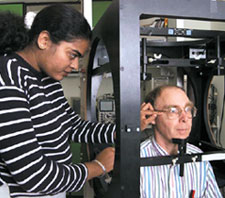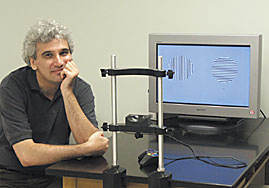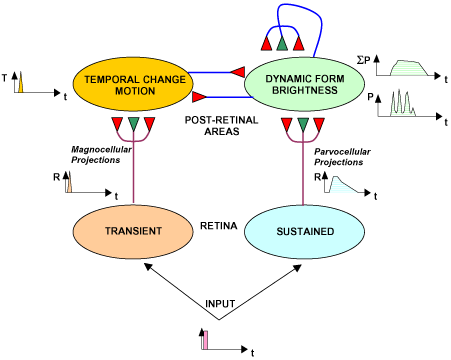Visual Perception
Participating Faculty
Drs. Harold E. Bedell, Bruno G. Breitmeyer, Haluk Ogmen, Bhavin R. Sheth.
Research
We conduct multi-disciplinary research covering various areas of visual perception and oculomotor control. There is a high degree of collaboration between the members of the group. Many of the projects listed below are joint collaborative projects by the members of the Center.

Harold E. Bedell’s ongoing research addresses interactions between eye movements and visual perception, in persons with normal and abnormal eye movement control. For example, his lab is evaluating whether visual sensitivity and the perception of target clarity are the same when retinal image motion is produced by movements of the eyes vs. physical motion of a target. A related question is how the visual system determines the location and movement of targets during different types of normal and abnormal eye movements. In persons with abnormal oculomotor control, such as individuals with congenital nystagmus, Harold Bedell’s research asks how the parameters of the eye movements limit performance on various visual tasks, and attempts to identify and characterize possible adaptive mechanisms that minimize the disruption of visual perception.

A major focus of current research interests in Bruno G. Breitmeyer’s lab is visual masking, with emphasis on the mechanisms contributing to paracontrast and metacontrast masking and how these relate to various levels and types of unconscious and conscious processing in the visual system. Here we are following up on theories of visual masking based on the dual-channel, sustained/transient approach. That approach, updated in the REtinal-COrtical-Dynamics (RECOD) neural network is being worked out in collaboration with Haluk Ogmen. A second area of interest is visual attention in relation to visual masking and to the distinction between space-based and object-based attentional deployment. Here we are particularly interested in determining how attention interacts with the processing of visual information in different cortical pathways and the stages/levels of cortical target-mask interactions at which attentional effects occur. A third area focuses on the relationship between Gestalt grouping, context, and figural organization and the visibility of component elements. We are using visual masking to investigate how target elements interact over time with larger stimulus groupings of which they are a part. The results should be relevant to an understanding of temporal development of perceptual grouping and feature binding. A fourth area focuses on the investigation of early visual processing and attention in schizophrenics. This research is being conducted in collaboration with Drs. Michael Green and Keith Nuechterlein of the UCLA Neuropsychiatric Institute. We are investigating early vision using well developed visual masking paradigms to look for vulnerability factors in schizophrenics and schizotypal individuals, with the aim of possibly relating these factors to genetic linkage studies. So far we have found consistent differences between control and schizophrenic subjects, the most notable being an absence/attenuation of gamma-range (40 Hz) oscillations in schizophrenic as compared to control subjects. A final area of interest, more from a purely scholarly perspective, focuses on the relationship between visual perception and visual art.

Haluk Ogmen’s research interests are in the dynamic aspects of vision. His research combines psychophysical, computational (neural modeling), and imaging approaches. The nervous system processes information on a time scale in the order of milliseconds. This is significantly slower than the time-scale of modern electronic devices. Yet, the real-time performance of the nervous system in most perceptual and cognitive tasks is beyond the reach of artificial systems. Our long-term goal is to “reverse-engineer” the nervous system in order to gain insights into the principles of information coding and processing in the brain. Currently active areas of research include the perceived form and position of moving objects, perceptual asynchronies across stimulus dimensions (such as color and motion), visual masking, visual memory, dynamic interactions between conscious and unconscious as well as perceptual and sensorimotor processes, and spatio-temporal dynamics of focal attention. All these questions are brought under the unifying theme and mathematical theory of how the brain represents and processes information. Of particular interest are the types of information representation schemes that lead to object permanence, dissociation of self from the environment, and the emergence of self-awareness and consciousness.
